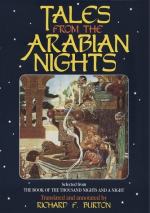[FN#131] Arab. “Tanjah"=Strabo {Greek letters} (derivation uncertain), Tingitania, Tangiers. But why the terminal s ?
[FN#132] Or Amidah, by the Turks called “Kara (black) Amid” from the colour of the stones and the Arabs “Diyar-bakr” (Diarbekir), a name which they also give to the whole province—Mesopotamia.
[FN#133] Mayyafarikin, an episcopal city in Diyar-bakr: the natives are called Fariki; hence the abbreviation in the text.
[FN#134] Arab. “Ayat al-Najat,” certain Koranic verses which act as talismans, such as, “And wherefore should we not put our trust in Allah ?” (xiv. 15); “Say thou, ’Naught shall befall us save what Allah hath decreed for us,’ " (ix. 51), and sundry others.
[FN#135] These were the “Brides of the Treasure,” alluded to in the story of Hasan of Bassorah and elsewhere.
[FN#136] Arab. “Isharah,” which may also mean beckoning. Easterns reverse our process: we wave hand or finger towards ourselves; they towards the object; and our fashion represents to them, Go away!
[FN#137] i.e. musing a long time and a longsome.
[FN#138] Arab. “Dihliz” from the Persian. This is the long dark passage which leads to the inner or main gate of an Eastern city, and which is built up before a siege. It is usually furnished with Mastabah-benches of wood and masonry, and forms a favourite lounge in hot weather. Hence Lot and Moses sat and stood in the gate, and here man speaks with his enemies.
[FN#139] The names of colours are as loosely used by the Arabs as by the Classics of Europe; for instance, a light grey is called a “blue or a green horse.” Much nonsense has been written upon the colours in Homer by men who imagine that the semi-civilised determine tints as we do. They see them but they do not name them, having no occasion for the words. As I have noticed, however, the Arabs have a complete terminology for the varieties of horse-hues. In our day we have witnessed the birth of colours, named by the dozen, because required by women’s dress.
[FN#140] For David’s miracles of metallurgy see vol. i. 286.
[FN#141] Arab. “Khwarazm,” the land of the Chorasmioi, who are mentioned by Herodotus (iii. 93) and a host of classical geographers. They place it in Sogdiana (hod. Sughd) and it corresponds with the Khiva country.
[FN#142] Arab. “Burka’,” usually applied to a woman’s face-veil and hence to the covering of the Ka’abah, which is the “Bride of Meccah.”
[FN#143] Alluding to the trick played upon Bilkis by Solomon who had heard that her legs were hairy like those of an ass: he laid down a pavement of glass over flowing water in which fish were swimming and thus she raised her skirts as she approached him and he saw that the report was true. Hence, as I have said, the depilatory.
[FN#144] I understand the curiously carved windows cut in arabesque-work of marble. (India) or basalt (the Hauran) and provided with small panes of glass set in emeralds where tin would be used by the vulgar.




